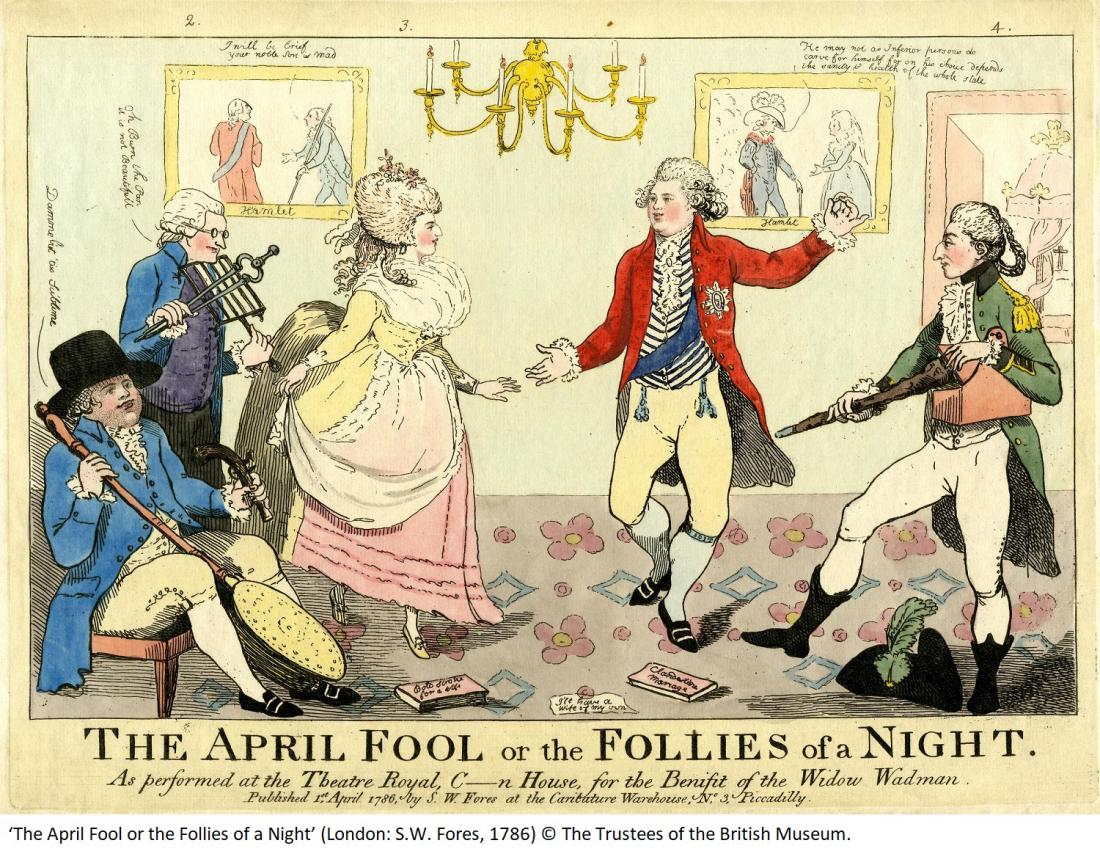
References to British Dance Instrumentation 1780s
Iconography
Tea pot stand of porcelain transfer-printed in black with a rustic scene of a man and woman dancing, Worcester c.1780, Victoria and Albert Museum, London http://collections.vam.ac.uk/item/O336729/stand-worcester-porcelain-factory
Francesco Bartolozzi after Giovanni Battista Cipriani, ‘Mr Fiervilles Ball’, 1780, British Museum https://www.britishmuseum.org/collection/object/P_C-2-130
David Allan, Highland Wedding at Blair Atholl, 1780, National Galleries of Scotland https://www.nationalgalleries.org/art-and-artists/8629/highland-wedding-blair-atholl, image visible on Wikimedia Commons https://commons.wikimedia.org/wiki/File:Allan-highlandwedding1780.jpg
Thomas Gaugain, [Peasants dancing] ([London]: T. Gaugain, 5 August 1780), The Lewis Walpole Library, Yale University https://hdl.handle.net/10079/digcoll/553230
Thomas Bewick, Painting IV, illustration to The Picture Exhibition: Containing the Original Drawings of Eighteen Little Masters and Misses (Glasgow: 1781), British Museum https://www.britishmuseum.org/collection/object/P_1882-0311-4237
Circle of Johann Zoffany, A Family Party - The Minuet, c.1780-1783, Kelvingrove Art Gallery and Museum, Glasgow Museums https://artuk.org/discover/artworks/a-family-party-the-minuet-86816
Francesco Bartolozzi after Giovanni Battista Cipriani, ‘Mr Fiervilles Ball’, c.1781, British Museum https://www.britishmuseum.org/collection/object/P_1897-1231-371
David Allan, Sir John Halkett of Pitfirrane, 4th Bart (1720-1793), Mary Hamilton, Lady Halkett and their Family, 1781, National Galleries of Scotland https://www.nationalgalleries.org/art-and-artists/29631/0/sir-john-halkett-pitfirrane-4th-bart-1720-1793-mary-hamilton-lady-halkett-and-their-family
Tickets to Balls, British Museum https://www.britishmuseum.org/collection/object/P_C-2-150-160
-
T Bonnor, ticket to 'Miss Fleming's Ball' (27 March 1781)
-
Ticket to 'Mr Gallini's Annual Ball Hanover Square' on 14 May 1782
William Angus after Thomas Stothard, ‘Tristram Shandy’, plate VII (London: Harrison & Co., 2 June 1781), Victoria and Albert Museum, London http://collections.vam.ac.uk/item/O766800/tristram-shandy-illustration-angus-william/
James Gillray, ‘The German Dancing Master’ (London: Hannah Humphrey, 5 April 1782), British Museum https://www.britishmuseum.org/collection/object/P_1868-0808-4819
Francesco Bartolozzi after Henry William Bunbury, The Dance (London: William Dickinson, 10 April 1782), British Museum https://www.britishmuseum.org/collection/object/P_1917-1208-951
‘The Cuckolds Reel’ from the Rambler’s Magazine, March 1783, British Museum https://www.britishmuseum.org/collection/object/P_1868-0808-4964
‘Coalition Minuet’ (London: Elizabeth Darchery, 29 March 1783), British Museum https://www.britishmuseum.org/collection/object/P_J-2-123
James Gillray, ‘Coalition Dance’ (London: William Humphrey, 5 April 1783), British Museum https://www.britishmuseum.org/collection/object/P_1851-0901-132
William Dent, ‘The Countryman's Dream of Coalescing Virtue and Vice’ (London: James Ridgway, 11 March 1784), British Museum https://www.britishmuseum.org/collection/object/P_1868-0808-5187
William Paulet Carey, ‘Fox’s Cotillon in St. James’s Market’ (London: William Holland, 15 April 1784), The Lewis Walpole Library, Yale University, https://hdl.handle.net/10079/digcoll/947488
‘The April Fool or the Follies of a Night’ (London: S.W. Fores, 1 April 1786), British Museum https://www.britishmuseum.org/collection/object/P_J-4-102
Thomas Rowlandson after Henry William Bunbury, ‘The Dance on Dun-Can’, part of Picturesque Beauties of Boswell (London: E. Jackson and G. Kearsley, May 1786), Victoria and Albert Museum, London http://collections.vam.ac.uk/item/O1158570/picturesque-beauties-of-boswell-print-thomas-rowlandson/
James Gillray, ‘The Royal Joke, _ or _ Sawbridge’s-Delight’ (London: S.W. Fores, 25 April 1788), British Museum https://www.britishmuseum.org/collection/object/P_J-4-108
Documentary Sources
Morning Chronicle 6 June 1781
KING’s THEATRE, HAYMARKET.
“After L’Omaggio was concluded, a cold collation was served…After the company had supped, they danced cottilions [sic], minuets, and country dances. We left them perfectly happy, footing it, in short time, to the harp, tabor and pipe, and violin, at three this morning.”
Norman Scarfe, ed. and trans., A Frenchman’s Year in Suffolk: French Impressions of Suffolk Life in 1784, Suffolk Records Society vol. 30 (Woodbridge: The Boydell Press, 1988/2001)
“Every town has an Assembly Room which is let for the occasion to the owner of a coffee-house or an inn-keeper. He takes the money and pays the bills, and so much the better if he makes a profit…The expenses to the entrepreneur consist of six or seven musicians and tea for the whole company, as much as they can drink, at the public balls.” [p. 42]
Jane Fiske, ed., The Oakes Diaries: Business, Politics and the Family in Bury St Edmunds 1778-1827, vol. 1, Suffolk Records Society vol. 32 (Woodbridge and Rochester: The Boydell Press, 1990)
14 January 1785 [p. 235]
“We gave a Ball at the Guild Hall: 13 dancing Ladys & 15 D[itt]o Gentn, in the whole abt 36 or 38. Supp’d in the Council Chamber…”
Gives a list of expenses which includes £1 6d for “2 Violins & Tabor”
Editorial note at the end of 1785 [p. 240] mentions “the first subscription ball notable for having ‘London musick’ costing seven guineas.”
Deirdre Le Faye, Jane Austen’s ‘Outlandish Cousin’: The Life and Letters of Eliza de Feuillide (London: The British Library, 2002)
Letter from Jane Austen’s mother to Phylly Walter, 31 December 1786 [p. 75]
“we have borrowed a Piano-Forte, and she [Eliza de Feuillide] plays to us every day; on Tuesday we are to have a very snug little dance in our parlour, just our own children, nephew & nieces…quite a family party”
Brian Robins, ed., The John Marsh Journals: The Life and Times of a Gentleman Composer (1752-1828), Sociology of Music No. 9 (Stuyvesant, NY: Pendragon Press, 1998)
1 October 1787 [p. 414]
“The next morning (Monday Oct’r 1st.) I left Sarum & went with Miss & Miss Mary White to Swathling, where we left the former at Mr Andrews’s, from whence Miss M. & I proceeded by ourselves to Havant where we dined & arrived by tea time at Chichester, where on the following day I accompanied Mrs M. & Miss White to the 1st. Assembly, at w’ch I danced with Miss Mary, it being then customary to dance the whole evening with one partner. The terms of these Assemblies (which were once a fortnight on Tuesday even’gs during the winter) were half a guinea per quarter, or a guinea for the season each person, tea included; or s4 each nonsubscriber, tea also included… The music was mostly by the Sussex Militia Band, of whom 8. generally attended, who used at this time to play military pieces during tea time…”
